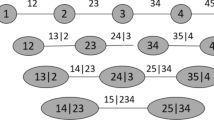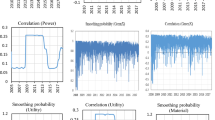Abstract
Understanding the risk spillover of the oil market in economic uncertainty is of great importance. However, it is difficult to take on a traditional single perspective in describing the risk spillover law of economic uncertainty in the crude oil market on different timescales. In order to fill the research gap resulting from such difficulty, this paper incorporates empirical mode decomposition into the time-varying Copula-CoVaR model, and for the first time explores the risk spillover path of economic uncertainty on the two international crude oil pricing benchmarks—Brent and West Texas Intermediate crude oil prices—using different timescales. The empirical results not only verify the necessity of research from the perspective of different timescales, but also reveal the heterogeneity of the risk spillover paths of different types of economic uncertainty on crude oil prices. The research in this paper provides a multi-perspective interpretation for understanding the complex risk spillovers between various economic uncertainties and the crude oil market, as well as providing meaningful information to support stakeholders in making rational decisions.







Similar content being viewed by others
Data availability
Not applicable.
References
Aboura S, Chevallier J (2013) Leverage vs. feedback: which effect drives the oil market? Financ Res Lett 10:131–141
Adrian T, Brummermeier MK (2016) CoVaR. Am Econ Rev 7:1705–1741
Aloui R, Gupta R, Miller SM (2016) Uncertainty and crude oil returns. Energy Econ 55:92e100
Antonakakis N, Chatziantoniou I, Filis G (2014) Dynamic spillovers of oil price shocks and economic policy uncertainty. Energy Econ 44:433–447
Bakas D, Triantafyllou A (2018) The impact of uncertainty shocks on the volatility of commodity prices. J Int Money Financ 87:96–111
Baker SR, Bloom N, Davis SJ (2016) Measuring economic policy uncertainty. Q J Econ 131:1593–1636
Barrero JM, Bloom N, Wright, I (2016) Short and long run uncertainty. https://papers.ssrn.com/sol3/papers.cfm?abstract_id=2807456.
Basu S, Bundick B (2017) Uncertainty shocks in a model of effective demand. Econometrica 85:937–958
Bernal O, Gnabo JY, Guilmin G (2016) Economic policy uncertainty and risk spillovers in the Eurozone. J Int Money Financ 65:24–45
Bilgin MH, Gozgor G, Karabulut G (2015) The impact of world energy price volatility on aggregate economic activity in developing Asian economies. Singap Econ Rev 60:613–421
Bloom N (2009) The impact of uncertainty shocks. Econometrica 77:623–685
Bollerslev T (1986) Generalized autoregressive conditional heteroskedasticity. J. Econom. 31(3):307–327
Bouri E, Chen Q, Lien D, Lv X (2017) Causality between oil prices and the stock market in China: the relevance of the reformed oil product pricing mechanism. Int Rev Econ Financ 48:34–48
Chan WH, Maheu JM (2002) Conditional jump dynamics in stock market returns. J Bus Econ Stat 20(3):377–389
Chang KL (2012) The time-varying and asymmetric dependence between crude oil spot and futures markets: evidence from the Mixture copula-based ARJI-GARCH model. Econ Model 29(6):2298–2309
Cheng IH, Kirilenko A, Xiong W (2015) Convective risk flows in commodity futures markets. Rev Financ 19:1733–1781
Gong XL, Liu XH, Xiong X (2019) Measuring tail risk with GAS time varying copula, fat tailed GARCH model and hedging for crude oil futures. Pacific Basin Finance J 55:95–109
Glosten L, Jagannathan R, Runkle D (1993) On the relation between the expected value and the volatility on the nominal excess returns on stocks. J Financ 48(5):1779–1801
Huang NE, Shen Z, Long SR, Wu MLC, Shih HH, Zheng QN, Yen NC, Tung C, Liu CHH (1998) The empirical mode decomposition and Hilbert spectrum for nonlinear and nonstationary time series analysis. Proc R Soc A: Math Phys Eng 454:903–995
Huang S, An H, Gao X, Hao X (2016) Unveiling heterogeneities of elations between the entire oil-stock interaction and its components across time scales. Energy Econ 59:70–80
Ji Q, Fan Y (2016) Modelling the joint dynamics of oil prices and investor fear gauge. Res Int Bus Financ 37:242–251
Ji Q, Liu BY, Nehler H, Uddin GS (2018) Uncertainties and extreme risk spillover in the energy markets: a time-varying copula-based CoVaR approach. Energy Econ 76:115–126
Joets M, Mignon V, Razafindrabe T (2017) Does the volatility of commodity prices reflect macroeconomic uncertainty? Energy Econ 68:313–326
Kang W, Ratti RA (2013) Structural oil price shocks and policy uncertainty. Econ Model 35(5):314–319
Li YY, Yan C, Ren XH (2023) Do uncertainties affect clean energy markets? Comparisons from a multi-frequency and multi-quantile framework. Energy Econ 121:106679
Liu BY, Ji Q, Fan Y (2017) Dynamic return-volatility dependence and risk measure of CoVaR in the oil market: a time-varying mixed copula model. Energy Econ 68:53–65
Liu ML, Ji Q, Fan Y (2013) How does oil market uncertainty interact with other markets: an empirical analysis of implied volatility index? Energy 55:860e868
Lyu YJ, Tuo SW, Wei Y, Yang M (2021) Time-varying effects of global economic policy uncertainty shocks on crude oil price volatility: new evidence. Resour Policy 70:101943
Maghyereh AI, Awartani B, Bouri E (2016) The directional volatility connectedness between crude oil and equity markets: new evidence from implied volatility indexes. Energy Econ 57:78e93
Mei DX, Zeng Q, Cao X, Diao XH (2019) Uncertainty and oil volatility: New evidence. Physica A 525:155–163
Mensi W, Vo XV, Kang SH (2023) Quantile spillovers and connectedness analysis between oil and African stock markets? Econ Anal Policy 78:60–83
Scheitrum DP, Carter CA, Revoredo-Giha C (2018) WTI and Brent futures pricing structure. Energy Econ 72:462–469
Syed QR, Bouri E (2021) Spillovers from global economic policy uncertainty and oil price volatility to the volatility of stock markets of oil importers and exporters. Environ Sci Pollut Res 29(11):15603–15613
Sheng JL, Li JC, Yang J, Wang YF, Li JY (2023) High-dimensional CoVaR risk spillover network from oil market to global stock markets—lessons from the Kyoto Protocol. Front Environ Sci 11:1103625
Tunc A, Kocoglu M, Aslan A (2022) Time-varying characteristics of the simultaneous interactions between economic uncertainty, international oil prices and GDP: a novel approach for Germany. Res Policy 77:102658
Wang XJ, Xu WK, Zhong ZD (2019) Economic policy uncertainty, CDS spreads, and CDS liquidity provision. J Futur Mark 39:461–480
Wang B, Wang J (2020) Energy futures and spots prices forecasting by hybrid SW-GRU with EMD and error evaluation. Energy Econ 90:104827
Wu RR, Qin ZF, Liu BY (2022) A systemic analysis of dynamic frequency spillovers among carbon emissions trading (CET), fossil energy and sectoral stock markets: evidence from China. Energy. 254:124176
Yao CZ, Liu C, Ju WJ (2020) Multifractal analysis of the WTI crude oil market, US stock market and EPU. Phys A: Stat Mech 550:124096
Yin L, Han L (2014) Macroeconomic uncertainty: does it matter for commodity prices? Appl Econ Lett 21:711–716
Zhang CG, Liu F, Yu DL (2018) Dynamic jumps in global oil price and its impacts on China’s bulk commodities. Energy Econ 70:297–306
Zhang YJ, Wu YB (2019) The time-varying spillover effect between WTI crude oil futures returns and hedge funds. Int Rev Econ Financ 61:156–169
Funding
The research is supported by the National Natural Science Foundation of China (grant no. 71973028).
Author information
Authors and Affiliations
Contributions
Tingting Zhang: methodology, data curation, visualization, and writing—original draft preparation. Zhenpeng Tang: guide research, writing—reviewing and editing. All authors read and approved the final manuscript.
Corresponding author
Ethics declarations
Ethical approval
Not applicable.
Consent to participate
Not applicable.
Consent for publication
We do not have any person’s data in any form.
Conflict of interest
The authors declare no competing interests.
Additional information
Responsible Editor: Roula Inglesi-Lotz
Publisher’s Note
Springer Nature remains neutral with regard to jurisdictional claims in published maps and institutional affiliations.
Appendix
Appendix
This section shows the specific forms of five Copula functions: Gaussian-Copula, Clayton-Copula, Frank-Copula, Gumbel-Copula and t-Copula. Different types of Copula functions have their own emphasis when describing the tail dependencies between variables. Gaussian-Copula function is the most commonly used copula function. Due to its obvious symmetry, the Gaussian-Copula function can better describe the symmetric relationship and linear correlation between variables, but it cannot describe the asymmetric relationship between variables. The t-Copula function takes into account the skew and peak of the data, and is more sensitive to the change of the tail correlation coefficient, so the correlation structure of the tail can be described more accurately. The tail of the Clayton copula function is asymmetric, which can more sensitively capture the change of the lower tail’s correlation coefficient. Frank copula function has been widely used because of its relatively simple and effective structure.
-
1.
Gaussian-Copula
Gaussian-Copula function, one of the most widely used Copula functions, has good upper and lower tail symmetry. For random variables (u, v), the expressions of the distribution function and density function of the Gaussian-Copula function are as follows:
-
2.
Clayton-Copula
The binary Clayton-Copula function describes the asymmetric binary correlation. Unlike the binary Gumbel-Copula function, the binary Clayton-Copula function can capture the lower tail correlation square more accurately, and its distribution function expression is as follows:
-
3.
Frank-Copula
Although Frank copula is also suitable for describing symmetric data, it has the special advantage of being able to describe the negative correlation between variables, unlike the Clayton copula and Gumbel copula. The binary Frank copula distribution function is expressed as follows:
-
4.
Gumbel-Copula
Compared with the Gaussian-Copula and t-Copula functions, the Gumbel-Copula function is asymmetric, with the upper tail being higher and the lower tail being lower, making it more sensitive and accurate in catching the relationship between the upper tail and the lower tail. The distribution function expression of the Gumbel-Copula is as follows:
-
5.
t-Copula
Compared with the binary Gaussian-Copula function, the binary t-Copula function can not only describe the binary phase-dependent structure with symmetric distribution, but also can describe the degree of tail correlation between variables in a more detailed way. The specific expression of its function is as follows:
Rights and permissions
Springer Nature or its licensor (e.g. a society or other partner) holds exclusive rights to this article under a publishing agreement with the author(s) or other rightsholder(s); author self-archiving of the accepted manuscript version of this article is solely governed by the terms of such publishing agreement and applicable law.
About this article
Cite this article
Zhang, ., Tang, Z. The dependence and risk spillover between economic uncertainties and the crude oil market: new evidence from a Copula-CoVaR approach incorporating the decomposition technique. Environ Sci Pollut Res 30, 104116–104134 (2023). https://doi.org/10.1007/s11356-023-29624-0
Received:
Accepted:
Published:
Issue Date:
DOI: https://doi.org/10.1007/s11356-023-29624-0




